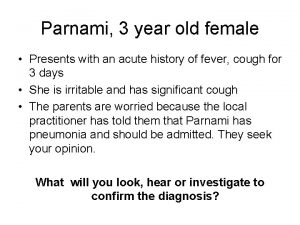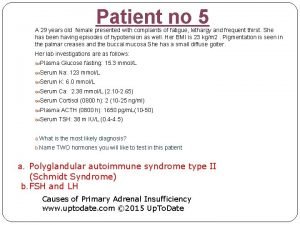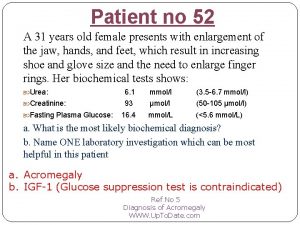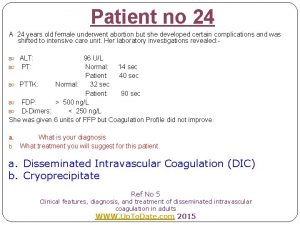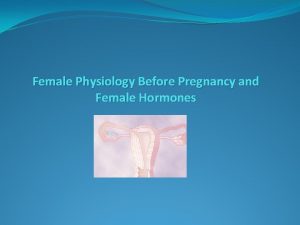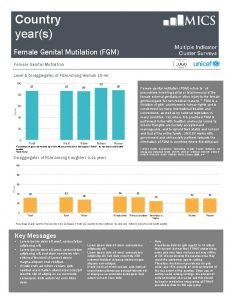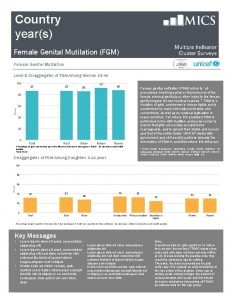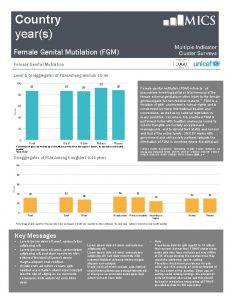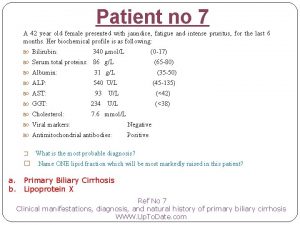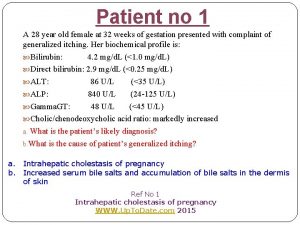Patient no 28 A 41 years old female














- Slides: 14

Patient no 28 A 41 years old female was hospitalized in the Oncology Clinic. The patient had four spontaneous fractures (foot, clavicle, upper arm, forearm) four years ago. She also reported poor appetite, nausea and vomiting every day during the last several months. Her biochemical profile is as following: Na: 141 mmol/L (132 -144) K: 2. 4 mmol/L (3. 2 -4. 8) Urea: 4. 3 mmol/L (3. 6 -6. 7) Ca: 3. 84 mmol/L (2. 1 -2. 65) P: 0. 81 mmol/L (0. 81 -1. 45) Alkaline Phosphatase: 205 U/L (24 -125) a. What is the most important diagnosis in this patient? b. Name ONE lab test you should advise to confirm your diagnosis? a. Primary Hyperparathyroidism (Hypercalcaemia of Malignancy is also acceptable diagnosis) b. PTH

Hypercalcaemia and Hypophosphataemia Increased Calcium and Low Phosphate are strong indicators of Primary Hyperparathyroidism and Hypercalcaeima of Malignancy In this patient clinical scenario favours parathyroid etiology because of relatively longer history and involvement of other systems but this diagnosis can not be reached just by Biochemical data. So malignancy is also an acceptable dignosis. PTH (i. e. Plasma i. PTH) will be a very good test to differentiate these two conditions. In malignancy it will be undetectable or vey low

Patient no 29 A 50 years old male complained of mechanical back and knee pains of a few years duration. On examination, there was mild restriction of the lumbosacral spine movement and patello-femoral crepitus. There was mild bone tenderness, too. His biochemical investigations were as following: Ca: 2. 34 mmol/L (2. 1 -2. 65) P: 0. 81 mmol/L (0. 81 -1. 45) Alkaline Phosphatase: 835 U/L (24 -125) Serum 25 -OH-D 3 : PTH : 35 ng/ml (30 – 150 ) 43 pg/ml (15 – 65) a. What is the most probable diagnosis? b. Name THREE further laboratory investigations will you order to confirm your diagnosis? a. Paget`s Disease of the bones b. (1) Bone Specific ALP, (2) Procollagen type I N terminal Propeptide (PINP) (3) Serum C telopeptide (CTx) (4) Urinary N telopeptide (NTx) (5) Urinary hydroxyproline Clinical manifestations and diagnosis of Paget disease of bone www. uptodate. com © 2015 Up. To. Date

Paget Disease of the bone One of the most common diseases of the bones Prevalence is upto 9% in some European countries Usually asymptomatic Bone pain and bone overgrowth are common symptoms in aging population High Serum Alkaline Phosphatase (ALP) is the hallmark of the disease If bone ALP is not available, liver origin can be ruled out by carrying out gamma GT. Bone turn-over markers are also elevated

Patient no 30 A 70 year old female visits a geriatric clinic for routine evaluation. She is rather short and has mildly low IQ. She has had lifelong hypocalcaemia and hyperphosphatemia. Recent values are: Serum calcium : 5. 2 mg/dl (8. 4 – 10. 2) • Serum phosphorus : 6. 2 mg/dl (2. 5 – 4. 5) • Serum Urea: 32 mg/dl (18 -38) • Serum 25 -OH D 3 : 30 ng/ml (15 – 60 ) • PTH : 130 pg/ml (15 – 65) • a. What is the most probable diagnosis in this case? b. Name any THREE subtypes of the disease a. Pseudohypoparathyroidism b. Type Ia, Type Ib and Type Ic Etiology of hypocalcemia in infants and children www. uptodate. com © 2015 Up. To. Date

Pseudohypoparathyroidism (PHP) Can occur at any age from infancy to senescence Biochemical Characteristics Ø Hypocalcaemia Ø Hyperphosphataemia Ø High PTH Types Ø Type 1 a Ø Type 1 b Ø Type 1 c Ø Type 2

Patient no 31 An 11 years old boy was being investigated for incidental finding of hypercalcemia. His lab results revealed: Serum Calcium: 3. 12 mmol/L (2. 1 -2. 6) Serum Phosphate : 1. 24 mmol/L (0. 8 -1. 4) Serum Magnesium: 1. 1 mmol/L (0. 6 – 1. 0) Plasma PTH: 25 OH vit D: Calcium creartinine clearance ratio: < 0. 01 55 ng/L (10 -65) 94 nmol/L (Normal: >75) a. What is the most probable diagnosis? b. What is the basic molecular defect? a. Hypocalciuric Hypercalcaemia b. Calcium Sensing Receptors defect Ref No 10 Familial hypocalciuric hypercalcemia www. uptodate. com © 2015

Familial Hypocalciuric Hypercalcemia (FHH) It is a ‘loss of function’mutation in ‘Calcium Sensing Receptor’ (Ca. SR) gene. In neonates the disease may present with ‘ Neonatal Severe Primary Hyperparathyroidism ‘ (NSHPT) The degree of hypercalcemia in these two disorder s reflects a gene dose effect. FHH heterozygotes have mild hypercalcemia because of partial loss of Ca. SR. In contrast patient who are homozygous for the Ca. SR gene defect have more marked disease i. e. NSHPT

Patient no 32 A one month old child is failing to thrive and unwell. His biochemical profile shows: Serum Calcium: 3. 21 mmol/L (2. 1 -2. 65) Serum Phosphorous: 0. 81 mmol/L (2. 1 -2. 65) Alkaline Phosphatase: 118 U/L (24 -125) Serum 1, 25(OH)2 D 3 : PTH : 55 ng/ml (30 – 150 ) 125 pg/ml (15 – 65) Urea 3. 9 mmol/L (3. 1 -6. 4) Creatinine 47 µmol/L (56 -82) Urine Ca / Creatinine Clearance Ratio: 0. 008 (Normal > 0. 01) a. What is the most probable diagnosis? b. Name the genetic abnormality present in this condition. a. Neonatal Severe Primary Hyperparathyroidism b. Calcium Sensing Receptor (Ca. SR) gene defect (homozygous variety) Ref No 1 Disorders of the calcium sensing receptor: Familial hypocalciureic hypercalcaemia and autosomal dominant Hypocalcaemia www. uptodate. com © 2015

Disorders of the Calcium Sensing Receptors Loss of Function Mutation: The inactivating mutations of the Ca. SR in FHH make the parathyroid glands less sensitive to calcium. A higher than normal serum calcium concentration is required to reduce PTH release Familial Hypocalciureic Hypercalcaemia (FHH): This is a heterozygous variety with following biochemical features: i. Mild Hypocalcaemia in childhood ii. Normal PTH iii. High Mg iv. Urine Ca : Creatinine Clearance < 0. 01 (cont. . )

Disorders of the Calcium Sensing Receptors Loss of Function Mutation: Neonatal Severe Primary Hyperparathyroidism (NSPH): This is the homozygous variety with following biocehmical features: Severe Hypercalcaemia in childhood ii. High PTH iii. High Mg iv. Urine Ca : Creatinine Clearance < 0. 01 i.

Disorders of the Calcium Sensing Receptors Gain of Function Mutation: Autosomal Dominent Hypoparathyroism This is due to shifting of Ca-PTH curve to the left, so the Ca level goes very low before a PTH response can ensue. Hypocalcaemia ii. Inappropriately normal PTH iii. High Phosphorous i.

Patient no 33 A 47 years old male had cough, dyspnoea and mild chest pain. His radiological examination of chest revealed diffuse interstitial lung disease and bilateral hilar adenopathy. His laboratory findings were: Haemoglobin: 11. 2 g/dl ESR: 31 mm at the end of first hour Calcium: 2. 85 mmol/L (2. 10 – 2. 65) Phosphorus: 1. 15 mmol/L (0. 81 -1. 45) ALP: 234 U/L (30 – 120) ACE: 178 U/L (8 -53) a. What is the most probable diagnosis? b. Which metabolite of Vitamin D will be most helpful to confirm the diagnosis? a. Sarcoidosis b. Elevated 1, 25 dihydroxyvitamin D a. b. Ref No 1 Clinical Manifestation and Diagnosis of Sarcoidosis. WWW. Up. To. Date. com Kavathia D, Buckley JD, Rao D, Rybicki B, Burke R. Elevated 1, 25 dihydroxyvitamin D levels are associated with protracted treatment in sarcoidosis. Respiratory Medicine (2010) 104, 564 570

Biochemical Features of Sarcoidosis Hypercalcaemia Hypercalciuria is also quite common Raised Alkaline phosphatase Hypergammaglobulinaemia Raised Angiotensin Converting Enzyme (ACE) Elevated 1, 25 -dihydroxyvitamin D
 Goat years to human years
Goat years to human years 300 solar years to lunar years
300 solar years to lunar years Four score and seven years meaning
Four score and seven years meaning Patient 2 patient
Patient 2 patient A 26 year old female presents
A 26 year old female presents Republic act no. 9344 is otherwise known as: *
Republic act no. 9344 is otherwise known as: * Under 15 years old
Under 15 years old Njbta
Njbta You nine years old
You nine years old Saki sredni vashtar
Saki sredni vashtar Hello
Hello Xxxbritt
Xxxbritt Hobby o hobbie
Hobby o hobbie How did judas die
How did judas die Despite being thousands of years old
Despite being thousands of years old




